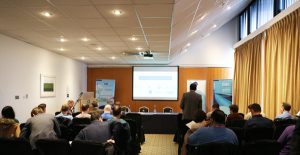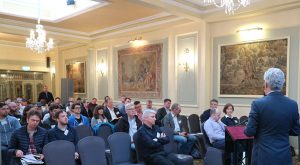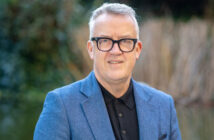The CitA Cork, Limerick and Waterford events took place late last month with great presentations from industry and academia.
BIMIreland.ie spoke to CitA South West BIM Region Co-Chair Tim Segal, CitA South East BIM Region Co-Chair Ellen Nugent, and CitA Southern Region Chair Ger O’Sullivan about the events.
Cork Event, River Lee Hotel, 29 March – Report from Ger O’Suillivan
Ted McKenna lecturer of structural engineering with the Department of Civil, Structural and Environmental Engineering at Cork Institute of Technology (CIT) opened the event with a comprehensive overview of how BIM methodologies and technologies are integrated within undergraduate and postgraduate education programmes in CIT.
Dr Barry McAuley presented on Ireland’s role in the global BIM movement based on his work with the BIM Innovation Capability Programme (BICP). The results are captured in the “Global BIM Study”. Click here to download:
http://arrow.dit.ie/cgi/viewcontent.cgi?article=1016&context=beschrecrep
Simon Tritschler, BAM, discussed the onsite application of lean principals using technology customised for use in the field and how BAM have adopted BIM as a lean process.
Robert Ryan, Arup, provided an overview of how Arup adopt BIM processes and technologies on infrastructure projects from the initial design stage to project completion.
Richard O’Farrell, EDC, showcased the practical application of Virtual Reality (VR) technology to provide an immersive experience for all project stakeholders leading to greater insights of the challenges faced.
David Purdon, Diatec, stressed the importance of technology to help drive BIM processes and deliver projects effectively. He also presented on generative design – getting the power of the cloud to optimise your design using algorithms.
35 people attended the CitA Southern Region Cork event. This event provided an excellent opportunity to meet likeminded professionals to discuss developments in the construction industry. It was great to see the interaction between the attendees both before and after the presentations and it was clear the ensuing conversations were prompted by the content of the presentations.
Limerick Event, Clayton Hotel, 29 March – Report from Tim Segal
After coffees and teas with an opportunity for delegates and sponsors to network, Paul Vesey of Limerick Institute of Technology (LIT) and Suzanne Purcell of CitA welcomed the group. Paul explained what LIT is doing in the BIM area.

Tim Segal of IT Tralee then described how BIM can work from the Client’s point of view. He outlined the work going on in the IT Tralee Estates Department to use BIM tools to track maintenance, operations and occupancy efficiency through the re-use of design and as-built data.
Javi Buron Garcia from the University of Limerick’s School of Architecture then explained the mission of the Fab Lab which has a location in Limerick City. He demonstrated some of the research activity and the ever-increasing capability of the Lab’s resources, as well as the potential for global collaboration through open source solutions to local questions.
BICP Researcher, Dr Barry McAuley presented the findings of the latest study on Irish and global adoption of BIM. He described where Ireland stands in the global context and outlined some of the issues facing the construction and infrastructure sectors here, including the question of an Irish BIM mandate at some point in the future.
Finally, Jonathan Argue from Topcon demonstrated some of his company’s current and developing solutions to surveying and construction setting out processes using cutting edge digital technology.
The event was attended by approximately 55 delegates from SMEs, large design and construction companies and the public sector including education providers, as well as representatives of sponsoring companies.
The presentations and subsequent Q&A session highlighted the excitement in the group at some of the possibilities presented by BIM at the moment, while demonstrating some serious concerns about implementation through the supply chain. It was clear from the discussion that BIM in isolation is not producing the level of benefits, particularly to SMEs, that would make investing heavily in a broader BIM roll-out easy in the short term. It is only through the buy-in of the entire supply chain, including subcontractors and product manufacturers, that the benefits of BIM will be realised. Clients must also get on board and make use of the data that is generated through the design and construction processes to more efficiently operate their facilities and feed into subsequent projects.
Waterford Event, Granville Hotel, 30 March – Report from Ellen Nugent
There were over 60 people in attendance for what was a series of interesting presentations, which provided an insight into the uptake of BIM on projects locally in the region.
Kevin Hickey spoke about BAM being the main contractors on the Courthouse bundle throughout Ireland. The renovation and extension to the Waterford Courthouse was used as a case study. Kevin talked about the advantages of using BIM software such as Revit for this project and mentioned that it was a great investment by BAM. He mentioned methods such as QR Coding using scanners, BIM Field 360 for uploading and managing drawings and documents and Autodesk Glue for managing federated models whereby clashes and any other issues could be addressed.

Gordon Chisholm, from Waterford Institute of Technology (WIT), spoke about the Waterford North Quays Project and the BIM Collective Research group at WIT. The North Quays project provided an overview of the Tri-varsity Interdisciplinary Workshop carried out with Sheffield Hallam University, VIA University and WIT last November. The key outcome of the project was to establish a clear project management structure for the delivery of a coordinated team to design, analyse and cost a 30 plus storey mixed use building as part of the redevelopment of Waterford.
Gordon provided an insight into the type of work carried out by the BIM Collective Research group in WIT. The purpose of this research group from the outset was to undertake applied research, in partnership with industry, to help facilitate this transition in terms of BIM processes and technologies. The BIM Collective (BIMC) has utilised various Enterprise Ireland (EI) and Science Foundation Ireland (SFI) funding programmes to enable Industry -Academia Partnership projects. These have covered a broad range of companies from architectural practices to large multinational corporations. Many of their partners are involved in, or seeking, competitive advantages in tendering projects in the UK and farther afield; these include projects in the UK, Europe or the Middle East.
Dr Barry McAuley, BICP Researcher, gave an informative presentation of global and Irish BIM adoption. Giving us an insight into the adoption of BIM in Ireland and also for Denmark as WIT had 20 students visiting Waterford and attended the event.
JP Kelly from Murphy Surveys spoke about the use of Scan to BIM Technologies. Murphy Surveys have identified specialised services for utilising BIM for client projects, they range from Lidar surveying for Irish Rail, Laser Scanning for detailed information on projects for clients ranging from Structural to MEP. An area of key interest was the use of UAV’s (Unmanned Aerial Vehicle’s), where large areas can be surveyed to produce orthorectified images (photogrammetry) of a building that could be structured together to produce a 3D model of that building.
BIMIreland.ie will keep you updated on future events as soon as details become available.
Follow BIMIreland.ie on LinkedIn and on Twitter: @BIMIreland




